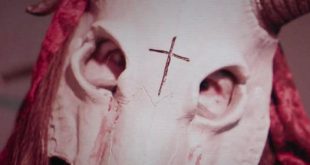
SYNOPSIS:
A family moves into a mysterious old mansion and begins experiencing disconcerting events and mounting horror as an unseen force seems to be feeding off their suffering and pain.
Directed by: Dan Curtis
Starring: Karen Black, Oliver Reed, Bette Davis, Lee H. Montgomery, Burgess Meredith
Burnt Offerings is about three-quarters of a good movie, but the missing quarter makes it almost impossible to understand exactly what is happening in this moody and atmospheric 1976 horror mystery. The movie is based on a novel of the same name by Robert Marasco, but in adapting the book for film, co-writer and director Dan Curtis left a little too much out, meaning that important plot points only really make sense if you’ve read the book. Nevertheless, what is on the screen is often very good, and makes you really wish that there was a little bit more so it would make better sense.
Curtis’s movie starts out as a bit of a bait and switch, teasing cast members Burgess Meredith and Bette Davis as stars of the film, but their parts are much smaller than one might expect. Instead, the story rests on the backs of Karen Black, Oliver Reed, and Lee H. Montgomery as a family who rent a Victorian mansion from some strange old siblings. Black and Reed, as the parents, are skeptical of the location, but circumstances and the right price conspire to get them to make their first and most consequential mistake: They agreed to the rental terms, including the strange stipulation that they live with the siblings’ elderly mother, who will never leave her locked room in the upper reaches of the house.


The family, along with an aunt played by Davis, move into the house, which is run down and surrounded by dead and dying vegetation. Ominously, however, their arrival seems to have caused some of the dead plants to start to come back to life. Over the course of the film, the characters experience increasingly horrific psychic attacks, and their increasing desperation leads inevitably to the film’s dramatic, and surprisingly gory, climax.
Here the movie starts to falter because of a failure of the production design. According to the novel, and a reasonable interpretation of the movie’s climax, the house is feeding off of the family’s pain to regenerate itself. But the production design doesn’t really convey the gradual restoration of the home, favoring a few dramatic instances of sudden and immense change. As a result, the story seems a little unclear because the film doesn’t support its plot visually as well as it might. Similarly, the use of the historic Dunsmuir House in California as the location for the mysterious mansion offers a mixed bag when it comes to production design. The house itself is an excellent example of Victorian architecture and looms menacingly, but its Spanish-style twentieth century pool, which is a major location in the film, is entirely out of keeping with the house’s style, and it cuts against the plot’s major point that the Victorian home has restored itself unchanged for a century.
But while the production design doesn’t always work, it’s grimy 1970s aesthetic, however, contributes to the mood of the piece, unintentionally, by emphasizing the rundown nature of the world in which this family finds itself. The 1970s were not the best time for fashion, hair, or colors other than olive and brown, but in the context of the movie, the horrors of the aesthetics actually work to enhance the horrors of the movie. As Black’s character descends into a madness familiar to viewers of Psycho and Reed finds himself overtaken by a rage he doesn’t recognize, the collapse of their minds is mirrored in the grimy, brown, and overgrown world of the 1970s. The era’s sense of collapse is repeated in its art, and this film is no exception.




This review certainly makes it sound as though the film is bad; but in places it works very well. Sequences of horror play out effectively, and the actors are generally well matched to their parts. But overall, the film’s impressionistic approach and formulaic plot structure rob it of some of the power that a subtler director and a sharper script might have conveyed. Burnt Offerings is an odd piece of 1970s horror, neither gory and explicit enough to be remembered alongside masterpieces like The Texas Chain Saw Massacre, but competent enough, and with an impressive enough climax, to keep it out of the lowest levels of Mystery Science Theater level midcentury dreck.
 Horror News | HNN Official Site | Horror Movies,Trailers, Reviews
Horror News | HNN Official Site | Horror Movies,Trailers, Reviews






Classics will never die!
This film is still remembered by my grandmother and remembered by my grandfather. This film is remembered by my parents, my elder brother and myself. 50 year ago was different time, then it was something exciting, it is possible to collect the whole family in front of the TV screen. I’m just writing an essay on “family time”. I decided to write myself, although my friend advised me use film to inpire. But such memories I will gladly embody myself, I do not need help!
Stephen King adapted the idea of a haunted house that feeds off of “the right person” from Burnt Offerings (the book) for The Shining. I’m fairly certain that the final shot in The Shining (film) was lifted by Kubrick from Burnt Offerings as well. One of my favorite books is Burnt Offerings; I agree the Curtis film doesn’t do it justice, but I love the Dunsmuir House and Eileen Heckart and Burgess Meredith as Brother and Roz.